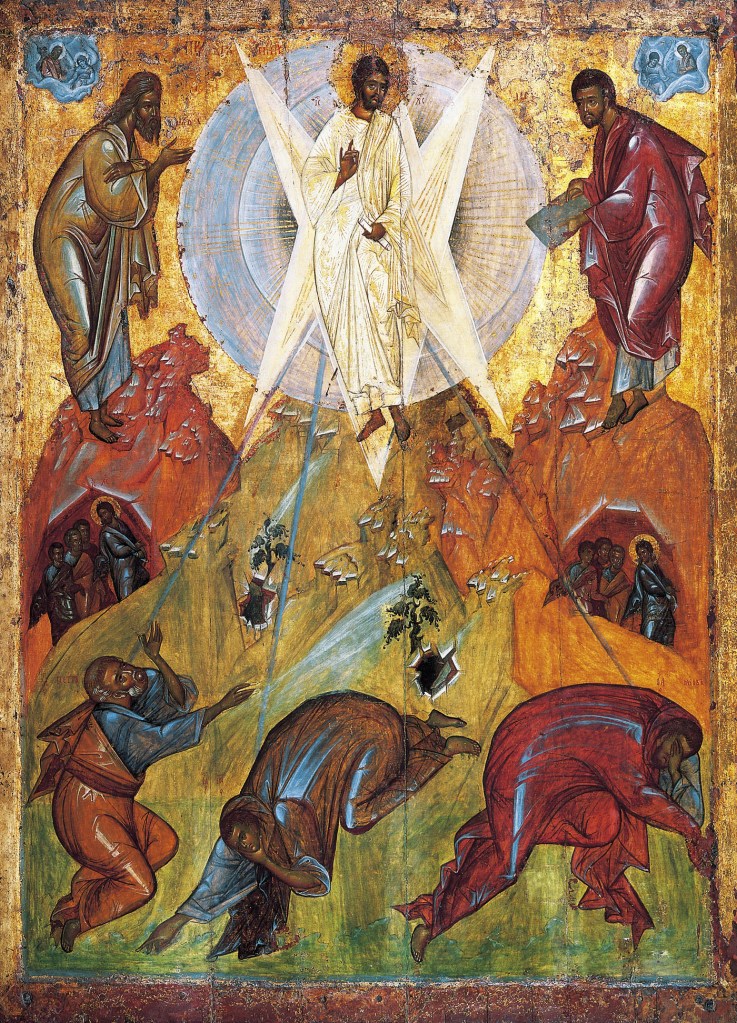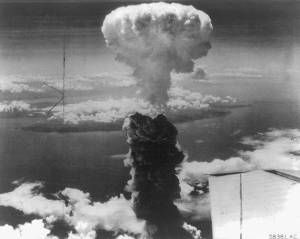
We here at Daily Theology are in the middle of our Vacation Bible School with many of our contributors offering insights into Scripture and how to read it with greater depth and understanding. I have enjoyed all posts and encourage readers to go back and explore if they have missed any. Today, August 6th, is an unusually rich day for biblical reflection and the prayerful space it can lead us. In many Christian denominations, today is the day to celebrate the Feast of the Transfiguration. Though the date was set as a universal feast for the Western Church in the 15th century, the Transfiguration has been an important text theologically from the very beginning of the Christian tradition. It’s meaning and importance is reflected in the themes and interpretations of the event itself. The transfiguration is linked to the Resurrection, to the meeting of Humanity and God (the Incarnation), to Jesus as lawgiver and prophet, and most significantly, to Christ who reveals both the Glory of Humanity and the Glory of God.
We will not be able to do justice to this immense topic in a blog post but hopefully we can receive some benefit if we first look very briefly at how the readings for today’s feast frame the topic. Once the context is set we can then turn to three aspects of this topic: Transfiguration reveals the Glory of God; Transfiguration reveals the Power of God; Transfiguration reveals the Vision of God.
Framing the Topic — Today’s Readings
The readings for today link together some interesting texts and taken as a whole they frame the issue in a very helpful way while laying the foundation for our understanding. The first reading on this feast day comes from the book of Daniel where the prophet reports a vision of judgment. Daniel sees an Ancient One on a throne. This Ancient One is white in appearance, both clothes and hair. His throne is fire and a great number serve this Ancient One. Then another being “like a Son of Man” — comes on clouds and is given glory and is appointed king over all. The Psalm of the day is one of the Enthronement Psalms, so-called because they may have been used on Jewish festival occasions, perhaps the Festival of Booths or Tabernacles, to celebrate God’s victory over chaos and disorder by a ritual act of enthronement. In the Psalm, God’s magnificence and honor are linked with thick clouds and darkness, righteousness, justice and because of this God is exalted above all else. The second reading from the second Letter of Peter links Jesus with the glory of God, and with a call to continue to pay attention to this great event.
Turning to the gospel, we hear of Matthew’s telling of the Transfiguration. Each telling of the Transfiguration by the different gospel authors have subtle differences and different narrative purposes for their various gospels as is common in the synoptic gospels. The Transfiguration, however, has the same context in all of the synoptic gospels. The Transfiguration is described immediately after Jesus explains to the disciples the nature of being a disciple and after he tells them he must die and rise again. Jesus then says that some will not die “before seeing the Son of Man coming in his kingdom.” This line then quite consciously alludes to Daniel’s vision.
Then Matthew reports that 6 days later, that Peter, James and John followed Jesus up a high mountain, where Jesus was “transfigured” — his face and clothes become dazzling white and Elijah and Moses, two figures that tradition held were taken bodily into heaven appear and speak with Christ. Peter speaks and claims his desire to set up tents/dwellings/booths (depending upon how you translate the Greek word) which allude to the enthronement psalm and God being king. Peter’s attempt to control the situation and prolong the vision is cut short by clouds, darkness and the voice of God proclaiming Jesus as “the beloved Son” and that the disciples should listen to him. Overcome by fear they fall to the ground but Jesus touched them and told them not to fear. As they come down from the mountain, Jesus orders them to tell no one of this vision until the Son of Man has been raised from the dead.
With this background, let us sketch out some connections that would allow the Wisdom of God to work on us further.
Transfiguration — the Glory of God, the Power of God, the Vision of God
What is transfiguration? Why is it important for us “to be attentive to it, as to a lamp shining in a dark place, until day dawns and the morning star rises in your hearts” as the Letter of Peter says?
The word itself in Greek is “metamorphothe” and is the same word used by Paul to describe a reordering by God — “a change in perception of our minds and bodies.” It is often described as a change in form but I am convinced (along with many other Christian writers over the years) this is an unhelpful way of phrasing it. The text does not seem to be about a transformation — a change from A to B so much as it is a change in the way we figure things out. It is something revealed underneath the outward appearance. It is not something we can control. It is reality fully revealed by God.
What is this reality? It is an ever-complex-ever-simple spiraling vision.
First it is the glory of God — the honor and magnificence given to God that is beyond complete description. This is symbolized by the mountain, the clouds, and the darkness in the readings. This vision that is revealed is at the edge of what humans can know and it is surrounded by Mystery and Awe. The disciples are so struck with wonder that they fall to the ground. Like the enthronement psalm, like Peter, all that one can do is sing praise at the glory revealed. But what is this Glory of God?
The glory of God is the power of God. It is a power of judgement but this too is transfigured. It is not power to crush or to manipulate. It is the judgement of righteousness and justice. It is power that is connected deeply with Christ. As was said above, before the transfiguration, Jesus tells the disciples what discipleship looks like. It is giving up one’s life, denying one’s self, taking up one’s cross and following Christ. In other words, the power of God is a dying to self. The power of God is not lording over others. It is a deep letting go. As Paul says in the letter to Philippians, Christ “emptied himself” and this letting go demonstrated God’s power. And Paul tells us in Philippians 3:21 (using the Greek word for transfigured mentioned above) that Christ will transfigure our bodies into a body of glory by the power that enabled him to make all things subject to him. In other words — through this power that looks like weakness to the world — through letting go and dying to self — we will come to a vision of God.
What is this vision of God? It is the moment when we see God. It is also the moment when God sees us. It is reciprocal. As Saint Irenaeus said — “The Glory of God is the human being fully alive; and the glory of the human being is the beholding of God.” When we behold God, God also beholds us. When we let go, when we allow for this humility and poverty of mind so that the self is overcome, we come to know deeply what transfiguration truly means. We also are elevated in glory. Pictured in the icon used at the top of this page, we can see on the left-hand side of the icon, the disciples follow Jesus up the mountain in a hierarchical pattern with Christ leading. After the vision, on the right-hand side of the icon, they come down the mountain all on the same level as Christ. They too have been transfigured.
Ultimately, what is the glory of God, the power of God, the Vision of God? It is God’s Wisdom. It is Christ, the very pattern and logic that the universe was created in and that can be born in us if we choose to follow him. This is an important choice with important consequences.
After this very brief exploration of the topic, we return to the present moment. Yes today is August 6th, the feast of the Transfiguration. August 6th, however, is also a date marking a very different event. Sixty-nine years ago today, the United States of America unleashed tremendous power and destruction when it dropped an atomic bomb on Hiroshima, Japan in an attempt to end World War II. These two events stand in stark contrast to each other united only by a date. Yet, side by side, these two events offer us a chance to hear again the Wisdom of the Word of God. I will not get into the details of war or the morality of the United States’ actions (to read a brief reflection on this topic see Dana Dillon’s post at Catholic Moral Theology) — but I would like to leave us with the image of the two clouds. The Cloud of the Glory of God that covers the mountain — and offered to us in the figure of Christ. A cloud of darkness that looks like death of the self. Power that appears like weakness in this world but is transfigured — revealed to be immense love and compassion.
And the second cloud. The one of power in this world supported by immense force.
In this current time, of wars around the world, with power and force on display in Gaza, in Iraq, in Syria, in countries, streets and households all over this planet, let the images of the two clouds capture our attention, allowing for Christ to be transfigured through us so we may go forth in the Glory of God.
Come Lord Jesus. Maranatha.


You must be logged in to post a comment.